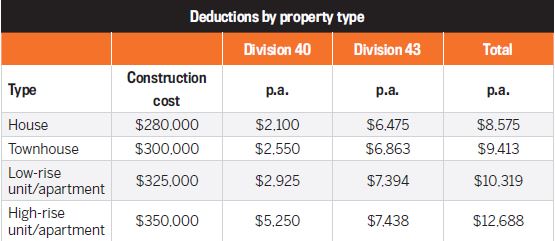Got tax queries regarding your property investments and wealth creation strategies? Our experts are on hand to answer them editor.yipmag@keymedia.com.au
Q: I am looking at buying my first investment property this year, and a friend has advised me to purchase a unit instead of a house for better depreciation benefits. I don’t quite understand how this works: houses are bigger, therefore shouldn’t the depreciation returns be higher? I would love some advice before I invest, as I’m aiming to keep my cash flow position as strong as possible (ideally I want a neutral or positively geared investment).
Thanks, Dale
A: Residential investment properties are usually classified into four main types of building: residential houses, townhouses, apartments or units (low-rise and/or high-rise). All these do allow you to obtain different types of capital allowance deductions.
If you are claiming under Division 40 on the above brand-new properties, you are generally entitled to claim the following percentages of the construction costs as a capital allowance:
a. Residential houses: 5–10%
b. Townhouses: 5–15%
c. Units/apartments, low-rise: 5–15%
d. Units/apartments, high-rise: 10–20%
The above percentages are a standard benchmark for fittings and plant and equipment that qualify for a deduction, and do not include any special fittings such as vacuum-ducted systems, electronic blinds, solar panels, high-quality kitchen white goods, etc.
You can also be entitled to a higher-percentage claim for units/apartments (high-rise), as you are allowed to claim your portion of the common property for items such as lifts and basement ventilation.

In addition to the above, if you purchase any new furniture to fit out your investment property, this generally can all be claimed in the first seven years.
With all these properties, in addition to Division 40 Capital Plant allowances you are also entitled to claim under Division 43, which is the construction cost of the property from the date its construction was completed.
The size, location and construction cost of the property will dictate what you can claim as a deduction for capital allowances. In addition, you may be able
to claim your entitlement to common property for the next 40 years.
Another factor to consider when chasing deductions is that if you purchase in a hotel/motel or a short-term accommodation strata-tiled property, the capital works are depreciated at 4% per annum of construction costs and not 2.5%. These investments usually come with a furniture package, which further enhances your total deductions to be claimed.
The above table highlights that if you are looking for maximum depreciation deductions, you should probably buy new and in a high-rise apartment.
• All building types allow you to obtain different types of capital allowances deductions.
• You can maximise depreciation deductions by buying a new high-rise apartment.
• New furniture bought for your investment property can generally be claimed in the first seven years.
Paul Mazoletti
is director of Napier & Blakeley Pty Ltd
Disclaimer: The advice contained in this article is for general information only and should not be taken as financial advice. Please make sure to speak to a qualified professional person before making any investment decision.
